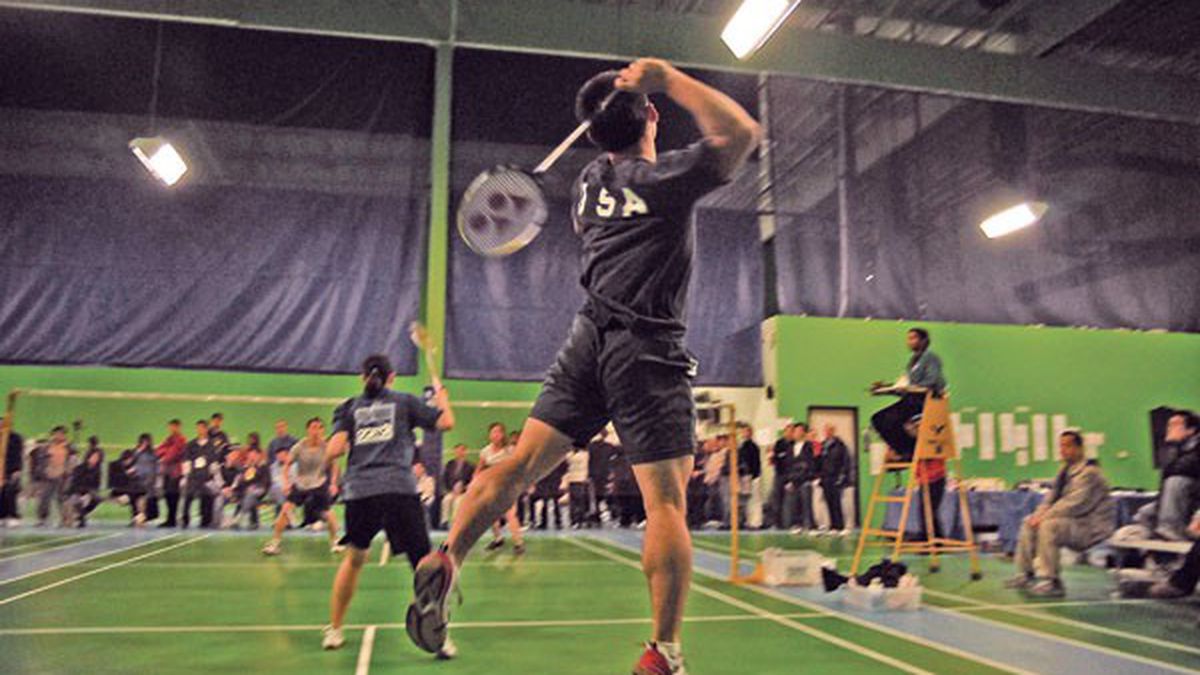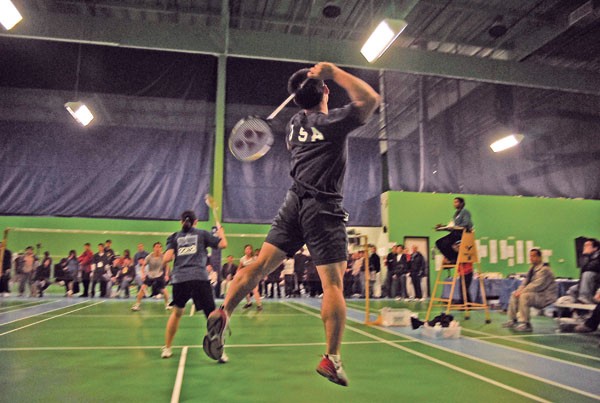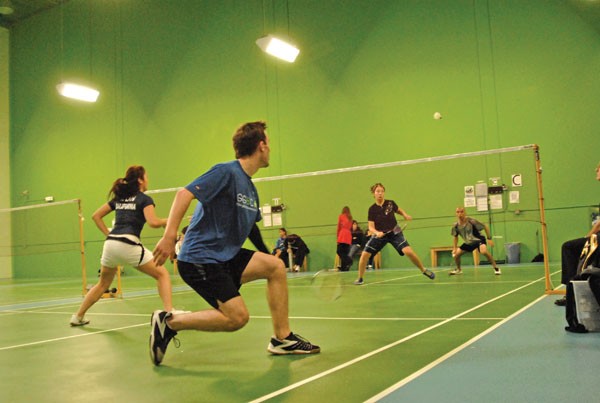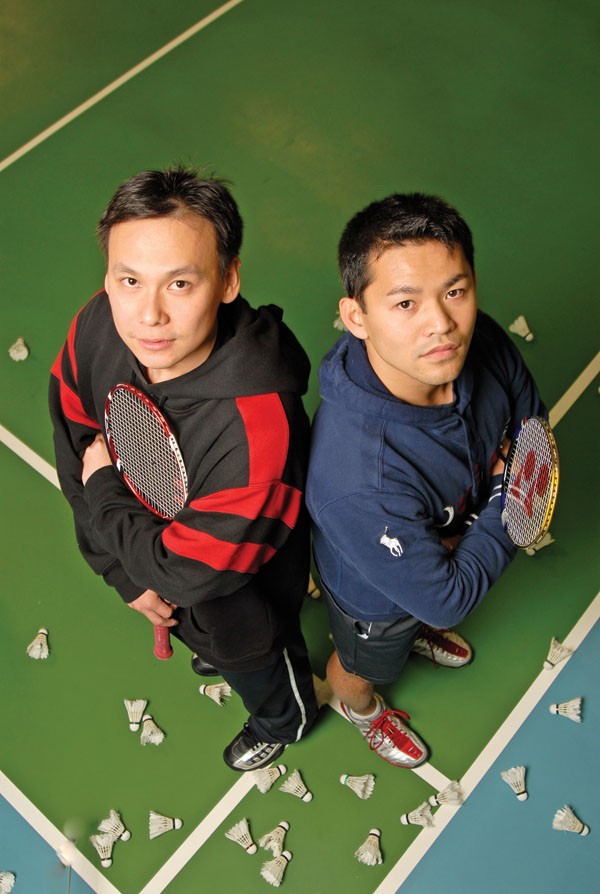On a chilly Tuesday night, nothing but the sleepy hum of the highway disturbed the silence of an Emeryville street. But inside a giant warehouse behind the railroad tracks, it was another story. Dozens of men and women filled the air with screeches, thumps, and screams of joy and frustration that released small plumes of white vapor into the equally cold air inside.
Emeryville’s Golden Gate Badminton Club is where those in the know come to play badminton — the world’s fastest racket sport, as well as its most misunderstood. As if to debunk the stereotype of the game as an outdoor activity for children, the courts were alive with the deep sound of taut rackets hitting the cork-and-feather shuttlecocks. Players alternated short and long strikes, trying to surprise their opponents with accurate drops and furious smashes or send them scurrying from side to side.

Olympians Howard Bach and Eva Lee played mixed doubles at the recent National Team Trials in Menlo Park. Credits: Craig Merrill 
Mike Yang hosted the National Team Trials at his Golden Gate Badminton Club in Menlo Park. Credits: Craig Merrill 
Emeryville badminton coash Ted Shear (foreground), competed in mixed doubles at the National Team Trials. Credits: Craig Merrill 

Dressed in sweatpants and T-shirts, players competed against one another or in pairs, periodically plucking white birdies from overflowing bins. Those who weren’t practicing sat on benches observing the games, resting between matches, or waiting for friends.
On one court, 72-year-old Ted Simas and a young male teammate played against a fierce Asian couple. Simas covered the front of the court near the net, compensating for a slight limp with powerful strikes that often took his opponents by surprise.
On another court, 23-year-old coach Ted Shear trained three women how to drop, a useful tactic designed to bring the birdie down from high up in the air with a semi-soft hit. A successful drop forces the opponent into a weak position of hitting the birdie from below. Shear showed one of the trainees the correct arm position and racket angle for an ideal drop. “It’s a great game because it’s one of the few sports that requires all kinds of movements — jumping, lunging, twisting, hand-eye coordination, and foot-eye coordination,” he said. “There’s a huge strategic element as well. On a high level, it becomes a game of physical chess.”
Yet despite its appeal to players such as Shear, until recently badminton was nearly impossible to practice in the Bay Area. Athletes had nowhere to play besides community centers, high schools, or ill-equipped and often unavailable basketball courts at UC Berkeley. “I would travel all over the Bay Area to find a gym,” recalled Simas, who lives in Castro Valley.
Former UC Berkeley badminton coach and entrepreneur Mike Yang thought the lack of badminton courts and clubs was especially strange given Bay Area’s sizeable population of Asian immigrants, many of whom value the sport. So in 2005, Yang, who emigrated from Taiwan in the late 1990s, opened Golden Gate Badminton Club in Menlo Park. In 2007, he added the gym in Emeryville, which is located in the former Ace warehouse on Hubbard Street.
“I’ve played in many places in the world and most big cities have professional badminton clubs,” said Yang, a muscular, tan 34-year-old with spiky black hair who prefers jeans over suits. “However, I was surprised there was no professional badminton club in the whole Bay Area.”
Since then, the situation improved rapidly. Other entrepreneurs have been opening gyms made specifically and solely for badminton, and today, Yang’s facilities are just two of nine badminton gyms that have sprung up in the Bay Area, both reflecting and facilitating the rise of interest in the sport. Now, the region is quickly assuming a place as the center of American badminton.
Yang played badminton with his family since he was a child and began training with a coach at the age of eighteen. He continued improving his skills in the Taiwanese military, where he made the badminton team. When he moved to the Bay Area, a friend told him that UC Berkeley was looking for a badminton coach. Yang gladly volunteered.
“They needed a coach and I needed a place to train,” he said. “At the time, it was so tough to find any place to even have the courts to train. So, it served two purposes — I loved to give back to the people who love the sport and second, I was able to train there myself.”
As a coach, Yang led the Berkeley badminton team to the top of the National Badminton Collegiates. As a player, he was ranked second in the United States in 2003. In addition to his badminton career, Yang was also studying architecture and design at California College of the Arts. Upon graduation, he decided to combine his skills and open his own badminton gym, which he helped design. After two years of searching for the right location, he settled on a warehouse in Menlo Park and sold his house to finance the new business, which like its Emeryville counterpart features green walls, blue floors, and side lighting designed to help make the white shuttlecocks easier to spot. The clubs also offer badminton supplies and training classes for children and adults.
As one of American badminton’s biggest proponents, Yang has brought several national competitions to the Bay Area, including the recent three-day National Team Trials held at his club in Menlo Park. This year, the free-to-watch tournament attracted 57 top players, a record number of the country’s best.
“That shows there are more top players in the US,” Yang said, with a smile. “I think US badminton entered a new chapter in the last three, four years since all the clubs opened. I believe the future of US badminton is pretty bright.”
One sign of the gyms’ success is evident in local junior championships, which have seen a rise both in attendance and the level of play. But even as badminton’s popularity grows in the Bay Area, one thing still prevents it from becoming a major American pastime — its misleading image as a backyard sport.
Badminton fans are always eager to point out that in its true competitive form badminton is strictly an indoor sport that should only be practiced in a controlled environment. Players who come to Golden Gate Badminton Club, for example, must endure a lack of both heating and air conditioning. Even the slightest air flow can create a draft deadly for the aerodynamic birdie, which is made from goose feathers and weighs a mere five grams.
Another common misconception about badminton is the strength and speed required to play the game. It’s one of the hardest sports to photograph or show on television because the birdie can fly as fast as 200 miles per hour and is often rallied back and forth at a tremendous pace, causing players to constantly move from one side of the court to another. Because of that, badminton players develop extremely muscular legs.
As the 72-year-old Simas put it defensively, “It’s not some sissy sport.”
Badminton didn’t always have such a bad rep in the United States. The first club opened in New York in 1878. According to Diane Hales, a former national champion who studied the history of badminton in America, it was promoted during vaudeville acts and by 1930s became quite popular. Colleges, YMCAs, and hundreds of newly formed clubs offered badminton lessons, and major celebrities like Joan Crawford, Ginger Rogers, and James Cagney were spotted carrying badminton rackets.
But the game began to struggle after World War II as clubs closed down. Just as football overshadowed soccer in the United States, Americans and the rest of the Western world gradually turned to badminton’s outdoor cousin, tennis. American badminton seemed to be going the way of the Dodo.
Meanwhile, on the other side of the world, the craze was just beginning. Over the last half century, badminton has become the most popular sport in a number of Asian countries, including China, India, Indonesia, and Korea. It’s also a major sport in Denmark. And as players from these countries moved to the Bay Area and Southern California, the United States began acquiring a critical mass of players good enough to dream of winning medals for their new nation.
“I’ve played badminton in Indonesia since I was five,” said Olympic gold medalist Tony Gunawan, who is now competing for the United States. “And to come here and see that it’s a backyard sport, where someone can play badminton while holding a beer in the other hand, it’s just not right.”
But even with the help of such players, no American has been able to claim a medal since badminton became an Olympic sport in 1992. The sport received some national attention last year in anticipation of the Beijing Olympics as Howard Bach, a Vietnamese American who grew up in San Francisco and became the world champion in 2005 by playing doubles with Gunawan, hoped to finally grab a medal. However, the attention died back down when he and his partner Bob Malaythong lost to the Chinese in the quarterfinals. Their bittersweet loss was America’s highest achievement in the sport.
Now, the badminton community is looking forward to 2012. If Gunawan, who won gold for Indonesia in 2000, receives a green card in time for the next Olympics, he plans to pair with Bach for a better chance of winning a medal. According to many leaders of American badminton, medals and top players are crucial to bringing notoriety to the sport.
“The reason we don’t appear in commercials is because we don’t have sponsors and we don’t have sponsors because we don’t have the players — it’s like a domino effect,” Bach said. “To jumpstart it again, we have to have badminton programs in elementary schools. You can’t continue to import players.”
For now, Bay Area badminton clubs that offer training to both young and old take the place of elementary schools. There are clubs in all corners of the Bay except in San Francisco, where the price of warehouse space is still considered to be restrictively high.
“It’s phenomenal to have that many clubs open for competitive training for younger kids, because when I was growing up here I had to train at the YMCA and compete with basketball players for court time,” remembered Bach, 29. “If I had this opportunity, I wouldn’t need to leave my home at the age of sixteen to train in the Olympic Training Center in Colorado. Now you have the luxury of training at home. It’s great for the world of badminton in general. Now we have to spread like a disease.”
Such grassroots enthusiasm for the development of the sport is what’s unique about the badminton community. The efforts of club owners, trainers, and players are all underlined with a desire to spread the word about their favorite sport. Evangelizing seems to go hand in hand with playing badminton.
“Part of why I love coaching is because I help introduce people to the sport,” said Shear, who both coaches and competes. “I love promoting the sport — just giving back to the sport that gave me so much.”
Jim Todt, who cofounded SmashCity, a badminton club in Milpitas, said his main reason for opening it was to provide a convenient place to play for his family, friends and neighbors.
“Badminton isn’t a sport you get rich on,” he said while watching his twenty-year-old daughter Lauren compete in the recent National Team Trials.
For Yang, however, the club is not just a hobby, but a viable business. With two locations to run, he employs ten coaches and ten managers who hold classes, sell memberships, buy equipment, and run the supply stores. Featuring Olympic-size 35-foot ceilings, synthetic floors, and even a lounge and a cafe upstairs, the first gym brought in enough profit to finance the second location. The combined gyms now attract close to 10,000 visits a month, Yang said, and the demand is growing constantly.
But even with this increase in popularity, badminton still feels like a community sport. Although several hundred people came to the three-day National Team Trials earlier this month, everyone seemed to know each other. Unlike in glitzier American sports, even the top players — Bach and Gunawan — were treated with no particular fuss. There were also many families — parents, couples, and siblings who came to compete, watch, and even judge the competition. Shear’s mother, Beth Sopka, for example, didn’t fly all the way from Massachusetts only to watch her son play. She also was there as an umpire.
“When Ted got into competing, it was boring going around all the tournaments, so I took up umpiring because it gave me something to do,” she said. “It was a great way to spend more time with him. Badminton is a fabulous sport that families can do together. It equalizes people in a lot of ways because it has so many different ways of winning. It allows you to play when you are young or old.”
With so many laudable qualities, badminton enthusiasts are convinced that the public will be converted — given enough time.
“I hope that, eventually, more Americans become aware what a great sport it is,” said former champion Hales, who has spent decades studying and teaching badminton. “I think it’ll be a long slow growth, I don’t think anything magical will happen overnight. We don’t have those promoters that we had in the ’30s. We don’t have vaudeville. There are so many sports now.”
But Bach, America’s greatest hope for a badminton medal, remains optimistic: “I think we need someone to continuously win to keep badminton on the map.” Or as Yang put it, “We need someone like Beckham — good-looking and good at PR.”

















